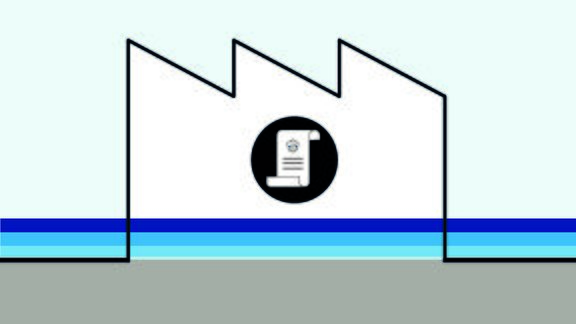Company emergency plan
Describe the action to be taken in the event of a flood in a company emergency plan. It should describe the coordination of emergency measures, the shutdown of processes and the measures to make a faster restart of activities possible after a flood.
- Always applicable;
- Crisis management;
- Emergency plan measure;
- Small investment;
- Prevents economic and environmental damage, and casualties;
- Applicable at all flood depths.

A company emergency plan includes all actions and protocols for communications, evacuation, shutdown and restart in the case of an emergency. In addition, you should also practise the steps in a plan at regular intervals so that you know how to act in the event of an emergency and limit the damage. In addition to emergency plans, officers from the company emergency services are needed to evacuate personnel.
Components of a company emergency plan
Evacuation plan
To ensure the safe and smooth evacuation of personnel and visitors, it is important to have a clear picture of who is present on the premises. A phased plan is needed that describes who should take what steps in the event of an emergency and lists the evacuation routes and safe locations. The company emergency services must be informed about these routes and the different evacuation groups.
Emergency kits for personnel
During a flood, vital utilities such as electricity, drinking water and gas may be disrupted. You should take steps to ensure that there are emergency kits for employees who need to escape. These emergency kits should include bottles of drinking water, non-perishable food, blankets, candles, waterproof wrapped matches and a whistle. You should make sure there are enough emergency kits distributed around the building. If there is time to prepare, you can still take essential supplies such as water and food to a dry floor. You can include this action in the emergency plan.
Periodical flood risk analysis
You should regularly review all the possible risks to which a company is exposed, including the flood risk, so that there is a clear picture of the possible consequences and possible action in the event of a flood. This risk analysis helps with the assessment of flood risk management measures. A risk analysis usually includes the following components: stating the risk and how probable it is, describing what may happen (impact), an assessment of the risks and prioritising measures. You should update flood risk analyses as soon as new flood scenarios are established, or when critical site or operational changes occur that may have an impact on the consequences of flooding.
Controlled shutdown
A plan should be drawn up for shutdown procedures in a controlled way during a flood. Determine the sequence and the underlying considerations. For example, you may decide to shutdown specific business processes as quickly as possible in a controlled way; in other locations, you may decide to maintain the electricity supply for as long as possible to support evacuation procedures. You should also enter into discussions with the utility company about their shutdown and start-up procedures.
Other relevant components in an emergency plan include:
- A list of important contacts such as suppliers, evacuation contacts for personnel and maintenance services, clients, power supplier, gas and water supplier, Rotterdam-Rijnmond Safety Region, Port of Rotterdam Authority, City of Rotterdam, contractor, plumber, pumping company and similar contacts needed after a flood;
- A description or map showing the vulnerable assets on site, protected locations, service or closure points for systems and facilities;
- Phased plan for protecting your own assets, shutting down installations and systems, preventing operational stagnation, and recovery or start-up after emergencies;
- Phased plan for the deployment and installation of a temporary emergency barrier;
- List of procedures for staff and managers to follow during emergencies;
- Clear location and description of positioning of various emergency facilities;
- Evacuation routes and location of refuge location;
- List of construction materials and quantities for use after recovery.
Back to the overview.
You can take these measures to improve your flood protection. The focus here is on generic descriptions of the measures in question. If you have questions about applying the measures on your site, please contact the Flood Risk Management Team.
No rights can be derived from the measures. See also the disclaimer.